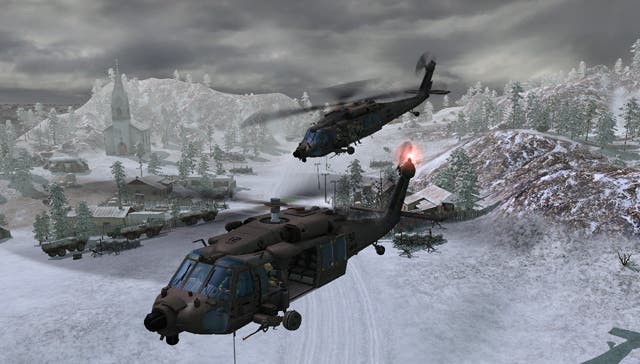Joint Task Force
E3: The world's first anti-war RTS?
It's not unusual to hear a developer claim that their latest game puts a new twist on an old genre. But Vincent van Diemen, producer of Joint Task Force, reckons that his latest effort not only takes RTS gameplay in a new direction, but throws a brand new element into the mix; JTF, it seems, is a game with a political message.
There are five campaigns to play through, set in Somalia, Afghanistan, Bosnia, Colombia and Iraq. Whilst van Diemen is aware that featuring conflicts which took place so recently could attract controversy, he believes that those who play the game will understand the thinking behind it.
"The bottom line is that it's very much an anti-war game as far as the story is concerned," van Diemen says.
"It can be tricky, but I think that if you look at the story and how the characters develop, and what the actual theme is, we can get away with it. There are all sorts of references to real life events... But we're trying to put these things in perspective."
The Joint Task Force of the title is an international military group which was set up as part of a G7 initiative. Their missions are less about invasion and elimination of the enemy, and more about protecting local civilian populations - which, as van Diemen explains, led the development team to rethink certain aspects of traditional RTS gameplay.
"First of all, this sort of setting doesn't really allow for any traditional resource collection. You cannot have your infantry cut trees or your snipers mine gold, so that was the first thing that we changed - the only resource in the game is money."
Cash converters

The money is supplied by the various countries who have signed up to take part in the JTF initiative, which means "it makes real sense to look after your reputation. If you're making a lot of civilian casualties, or destroying civilian property, less countries will be willing to participate - thus your funding will decrease."
Everything you do will be watched by the world's media, and it's your job to ensure their safety whilst within conflict zones as well as that of local civilians. To earn extra cash, you can complete additional humanitarian missions, which will attract more support for the JTF and therefore more funding.
That's in between completing your primary objectives of course, which are presented using what van Diemen describes as a "dynamic mission structure." In short, "Once you start a scenario, you will not be presented with the whole map for that scenario, but only with a sector. Every sector has a number of objectives; once you've completed them, another sector will open."
To demonstrate how this works, van Diemen takes us through one of the missions set in Bosnia. Your first task is to capture a small village, progress along the road, eliminate the threat posed by an enemy bunker and then take control of an airstrip. Once you've done all that, the map will open up, revealing a new area to explore and a new set of objectives to complete.
In the case of this mission, you'll then have to ensure that the road ahead is safe for UN trucks packed with refugees to traverse, taking out a load of guns and generators along the way. This will unlock the third sector, which sees you controlling SAS troops who have been dropped in to take over another bunker and a radar post. Enemy forces will try to retake the positions, so you'll have to see them off before the final sector is unlocked.
Counting the hours

"Sometimes a mission will consist of two sectors, sometimes four or five," says van Diemen.
"This mission offers about two or two and a half hours of gameplay. I don't think that's the average, but the average is definitely one hour to an hour and a half, and there are 20 missions in total."
There's plenty of work to do, then, especially since you start each mission with a relatively small task force. But helpfully, there's a lot of scope for modifying your units depending on the situation you're faced with. That goes for the armoured units - you can put a machine gun or an anti-tank weapon on a hummer, for example - but also for individual soldiers.
"There are lots of different secondary weapons; you can order them, but sometimes they are either dropped by infantry that are killed or found on the ground," van Diemen says.
"There are grenades, C4, sniper scopes, gas masks, explosives, so you can actually booby trap things in the game... There are a lot of different things you can use to tailor your team for the task ahead." You can also call for extra support if things get tricky, in the form of cluster bomb raids and the like, and request additional information when you're planning your next move; satellite images can come in very handy, for example. Your options will increase as missions progress - so once you've captured that airfield, you can order aircraft to drop by with heavier reinforcements.
On top of all that, there's the option to confiscate and use of enemy equipment and weapons, "Albeit with a small penalty. If you're not trained to use such equipment, you'll get a small disadvantage as far as range is concerned, or speed, or damage or whatever."


